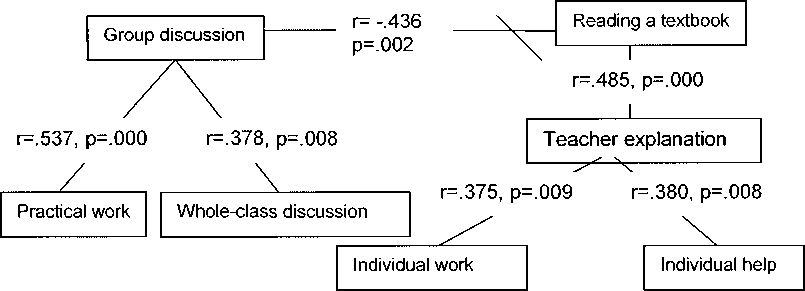155
Whole-class discussion, Group discussion, Practical work and Using a computer. The
other group consisted of Individual help, Teacher explanation, Reading a textbook and
Individual work. However, some teaching methods were perceived to relate relatively
strongly, others relatively weakly (see Figure 4.4.16 in appendix).
Deployment
Figure 4.4.17: Correlations between teaching methods in terms of the frequency of the
deployment: 5th grade teachers

Figure 4.4.17 indicates that for 5th grade teachers, the teaching methods deployed in
mathematics classes were divided into two groups. One group consisted of Whole-class
discussion, Group discussion and Practical work. The other group consisted of Reading
a textbook, Teacher explanation, Individual work and Individual help. There was a
negative correlation between Group discussion and Reading a textbook, in terms of the
frequency of their deployment in mathematics classes. For 8th grade teachers, the extent
of deployment of Group discussion was correlated with Practical work and Whole-class
discussion. There were no significant relationships between the other teaching methods
(see Figure 4.4.18 in appendix).
For 5th graders, the perceived frequency of deployment of Practical work and Group
discussion, and Teacher explanation and Whole-class discussion were moderately
correlated in a positive direction (see Figure 4.4.19 in appendix). For 8th graders, the
perceptions of deployment fell into two groups. Practical work, Whole-class discussion
and Group discussion were moderately correlated in terms of the frequency of the
155
More intriguing information
1. The name is absent2. Markets for Influence
3. The Role of Evidence in Establishing Trust in Repositories
4. SLA RESEARCH ON SELF-DIRECTION: THEORETICAL AND PRACTICAL ISSUES
5. Creating a 2000 IES-LFS Database in Stata
6. THE ANDEAN PRICE BAND SYSTEM: EFFECTS ON PRICES, PROTECTION AND PRODUCER WELFARE
7. NEW DEVELOPMENTS IN FARM PRICE AND INCOME POLICY PROGRAMS: PART I. SITUATION AND PROBLEM
8. The name is absent
9. A Brief Introduction to the Guidance Theory of Representation
10. MULTIPLE COMPARISONS WITH THE BEST: BAYESIAN PRECISION MEASURES OF EFFICIENCY RANKINGS